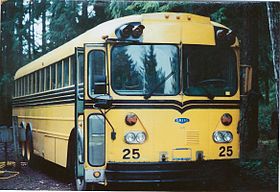| Gillig Transit Coach | |
|---|---|
 1977 Gillig 97-passenger Transit Coach Model DT-16, one of the largest school buses ever produced | |
| Overview | |
| Manufacturer | Gillig Brothers (1940–1969) Gillig Corporation (1969–1982) |
| Production | 1940–1982 |
| Assembly | Hayward, California |
| Body and chassis | |
| Class | Type D (transit-style) |
| Body style | School Bus |
| Layout | Body-on-frame
|
| Platform | Gillig |
| Powertrain | |
| Engine | Gasoline
Diesel [1][2] |
| Capacity | 60–97 passengers |
| Transmission |
|
| Dimensions | |
| Length | 28–40 feet (8.5–12.2 m) |
| Width | 96 inches (2.4 m) |
| Chronology | |
| Successor | Gillig Phantom School Bus |
The Gillig Transit Coach School Bus is a series of buses that were produced by the American bus manufacturer Gillig from 1940 to 1982. Alongside its namesake usage as a yellow school bus, the Transit Coach also served as the basis of motorcoaches and other commercial-use vehicles. Marketed primarily to operators on or near the West Coast of the United States (California, Washington State, or Oregon), the Transit Coach competed nearly exclusively against the similar Crown Supercoach through much of its production.
The Transit Coach was the first school bus produced with a mid-engine layout and would be among the first to use a diesel-fueled engine. The model line also offered the highest-capacity school bus ever produced, offering up to 97-passenger seating (current design standards restrict maximum capacity to 90).
After 1982, Gillig discontinued the Transit Coach after 42 years of production, concentrating its resources on the Gillig Phantom transit bus. For 1986, the company reentered school bus production, developing a school bus variant of the Phantom that was offered from 1986 through 1993; the high-floor Phantom was manufactured through 2008.
The Transit Coach was manufactured by Gillig in its now-former facility in Hayward, California; while no longer a manufacturer of school buses, Gillig currently exists as the second-largest American manufacturer of transit buses.
- ^ "Gilligcoaches.net" (PDF). Archived from the original (PDF) on 2009-09-20.
- ^ "Gilligcoaches.net" (PDF). Archived from the original (PDF) on 2009-09-20.
- ^ "Gilligcoaches.net" (PDF). Archived from the original (PDF) on 2009-09-20.